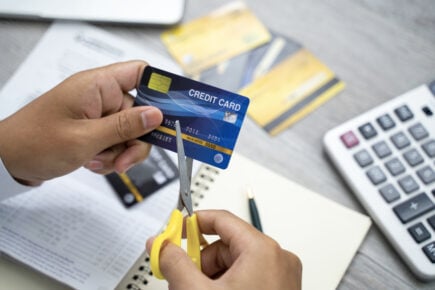If you have a 0 per cent interest balance transfer credit card, you need to be aware that at the end of the balance transfer period your interest rate could go sky-high. Indeed, it’s worth trying to clear the debt before the end of your interest-free period to avoid being hit with large interest charges on your outstanding balance.
Credit card providers offer 0 per cent interest balance transfer periods in order to attract new customers and to make money when the interest-free period is over, or on purchase transactions. Below we look at what happens at the end of your interest-free balance transfer period in more detail and further explain how you can ensure you don’t lose out.
What is a balance transfer period?
A large number of credit card providers offer borrowers with expensive credit card debt the opportunity to transfer their balance onto one of their credit cards without paying any interest for a fixed introductory period. This ranges from around 20 months to around 35 months, depending on the provider.
During this ‘balance transfer period’ borrowers must make regular monthly minimum payments onto their credit cards, but the entire amount goes towards paying off their debt and nothing is paid in interest. As a result, this is a great opportunity for anyone with expensive credit card debt to clear that debt cheaply. However, if the debt is not cleared within the balance transfer period, the interest rate reverts to the provider’s standard balance transfer rate, which is often around 20 per cent or more.
- Find the deal with the cheapest initial fee and the right balance transfer period for you
- Clear your debt within the balance transfer period
- Don’t make any purchases on the balance transfer card
- Don’t withdraw any money on the balance transfer card
- Ensure you make minimum required monthly repayments
How can I clear my debt within the balance transfer period?
Clearing your credit card debt within the balance transfer period should be your priority when taking out a balance transfer deal. This takes planning, motivation and discipline. As the entire amount you repay will be going towards reducing your debt, you can plan how much you need to pay off each month to clear the debt within the balance transfer period. It’s then advisable to set up a direct debit for that amount and make sure you have the money in your current account each month to honour the payments.
Steps to paying off debt within the balance transfer period:
- Calculate the required monthly payment to clear the debt within the balance transfer period
- Set up a monthly direct debit for that amount
- Ensure enough money is in your current account to cover the direct debit
What should I do if I don’t clear my debt with the balance transfer period?
If you are nearing the end of your balance transfer period and you have not cleared your debt, you have several options:
- Move your balance to another 0% balance transfer card: Although you will need a pretty healthy credit profile to do it, you may be able to transfer your outstanding balance onto another interest-free balance transfer credit card before your current deal period has ended. Remember though, there will be an initial balance transfer fee to take into account. This is the ideal solution, but you will then be faced with the same situation once more and should take steps to try to clear the debt within the balance transfer period to avoid a further repeat of the situation in a couple of years’ time.
- Move your balance to a lower-interest credit card (or even back to the original card): You may go for this option for a number of reasons. You might have cleared enough of the balance that it is now in a comfortable zone for you, or you may want to start making purchases or withdrawing cash on the card. Moving the balance onto a low-interest credit card can be much cheaper than leaving the debt on the balance transfer card once the initial offer period is up, as the interest rate is likely to skyrocket to upwards of 15 per cent.
- Leave the balance on the balance transfer credit card: This is an expensive option, as the standard balance transfer rate on credit cards tends to be very high. This is the option that most credit card firms hope you will take when they offer you the initial interest-free balance transfer period deal. Many people simply fail to take the steps necessary to move their balance around once the balance transfer period is up.
What to watch out for when looking for a new balance transfer deal
- If the offer says ‘up to’, those with poorer credit scores may be offered shorter balance transfer periods
- Applying for lots of credit card deals can damage your credit score so research your eligibility before applying
- Check the transfer fee charged by the provider to establish the total cost to you
- Check the interest rate the card reverts to after the balance transfer period
- Does the card allow you to make purchases at 0 per cent interest within the balance transfer period?
- If your credit rating isn’t great, you may save money by shifting your balances around the cards you already have.
Dive even deeper

What is a Credit Card?
If used correctly, a credit card can be a convenient way to borrow money to pay for goods and services. There are several different types available, including balance transfer cards and credit cards for bad credit, which is why it makes sense to shop around to find the one that’s right for you.

3 Reasons to Cut Up Your Credit Card and 3 Reasons to Keep It
Cancelling your credit card may seem the obvious next step if you’ve managed to pay off your balance in full. But there are several factors you need to consider before deciding whether to get rid of your card, including the effect it could have on your credit history.

Stoozing: Free Cash or Debt Trap?
Stoozing is a way of using a 0% interest credit card to allow you to maximise the money you can make on your savings. But there are risks involved with this money hack, so is it worth trying?

